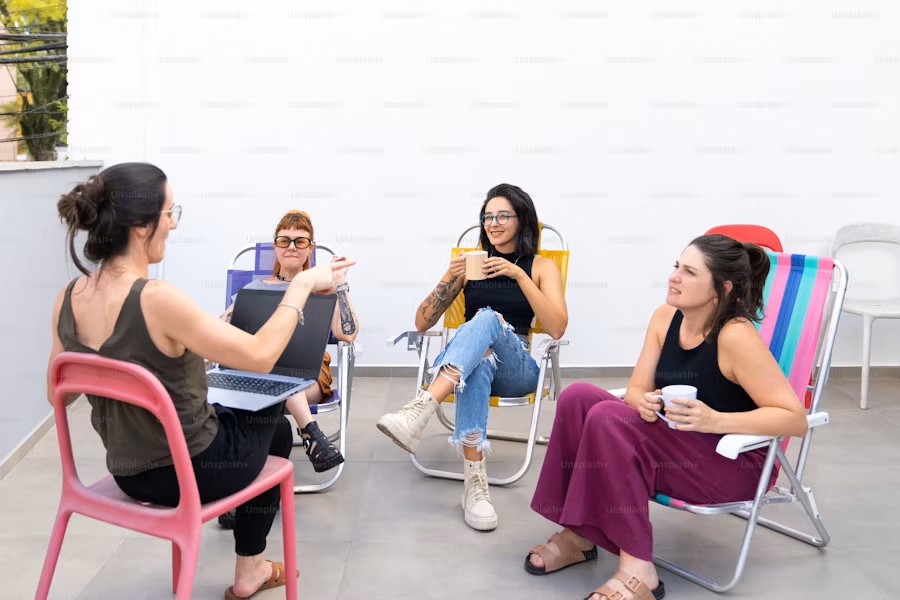Role theory and distancing are used in dramatherapy to assist clients to gain insight into their difficult issues and areas for healing. In dramatherapy, a ‘role is invoked by helping a client reach into the system and extract one that needs to be expressed and examined’ (Landy, 1993, p. 46). In this way the Dramatherapist and client work together to develop and explore roles that the client wants to either increase or diminish in their lives, and issues that are evoked by certain characters the client creates.
Role in dramatherapy also presents the opportunity for clients to use distance to process and work through their difficult issues. Aesthetic distance, in enactment, ‘refers to the ability to be in role either as oneself / part of oneself or another real or fictional self, retaining a healthy balance between cognition and affect: between thinking and feeling’ (Birdfield, 1998, p. 25). This is particularly important for clients to process the behaviours and reasons for their behaviours, and the thoughts and feelings that are causing them harm, as we need to engage both cognitively and emotionally with our difficult issues for change to occur.
Dramatherapy uses role in many of its activities and techniques to facilitate clients’ insight into themselves, their issues and their areas for change. Professor Robert Landy of New York University developed role theory in dramatherapy, doing extensive research into the use of role, and developing a taxonomy of roles taken from western literature. Landy asserts that ‘in drama therapy, both client and therapist work in role and through role…[and that]…role may be, in fact, the single most significant feature that distinguishes drama therapy from other forms of psychotherapy and healing’ (1991, p. 29).
Unlike other talking therapies, in dramatherapy a client is able to explore issues and concerns through role-play, improvisation and script work, playing a role that is a part of themselves, or represents an aspect of themselves or their lives, resulting in experiencing greater feelings, empathy and insight into the role and what that role means to them. Through embodying the role a client is able to feel where the stress the role causes them sits in their body, giving insight into what type of stress it is for them. Through thinking like the role, and talking from the role’s perspective, the client is able to gain greater insight into how the role thinks and behaves and how that relates to their own identity, beliefs, or aspects of their lives. Landy suggests that through roles people can find a better understanding of what they value and who they are, and can create meaning in their lives (Landy, 1992, p. 421).
The Dramatherapist, ‘in noting the type of role that a client invokes in drama therapy…is given a glimpse of a part of the person that needs to be seen, heard and acknowledged’ (Landy, 1991, p. 29). By inviting clients in a dramatherapy session to choose a role, either one from their own life, a fictitious role or one from an existing story or play depending on the activity, the client may choose quite subconsciously a role that represents something that they need to work on at that time. The client’s choice of role gives the client and the Dramatherapist the opportunity to reflect on what the role represents for the client, and what difficult issues this may illicit for the client. Role presents an opportunity for the client to explore aspects of themselves, their relationships and gain greater insight into their thoughts and behaviour.
Along with role being an effective tool for gaining insight, it is also used in dramatherapy to help develop strengths in the client and for the client to heal and grow through their experience of embodying different roles. Haen, in his article The Dramatherapeutic Use of the Superhero Role with Male Clients, explains that ‘Dramatherapists have found that, regardless of disability, social standing or circumstance, clients can feel empowered within the dramatic space…[and]…by taking on a role of power, the client can access the parts of himself that have ego strength, leading to a greater competency’ (2002, p. 18). By experiencing the feelings and thoughts that are created through adopting a powerful role, the client can start to relate the behaviour of the role to their own life and behaviour. The role is able to ‘model’ the characteristics a client is hoping to take on, and by rehearsing these characteristics in the dramatherapy space clients can become more confident in using them.
Further to building strengths and becoming more empowered through the playing out of various roles, using role in dramatherapy can also assist the client to understand and relate to the different roles that make them the people they are. Landy believes that we are made up of the different roles we use in different contexts, and that the therapeutic goal of using role in dramatherapy is to learn to live in this role ambivalence so that one powerful role becomes less overpowering to the system of roles (Landy, 1992, p. 14). Through exploring our different roles – such as our interpersonal roles, professional roles, cultural roles, gender roles – we can develop the roles that we want to increase in our life and soften or minimize roles that have been overpowering, especially if they are negative roles in our lives. For example a client who has a dominant professional role but who wants to spend more time in one of their family roles, may strengthen and build up this role through role-playing and interacting with their family role in dramatherapy. Managing our various roles, and the role ambivalence that we experience at different times, allows us to move more fluidly between them, and spend more time in the roles that serve us better in our lives.
Using role in dramatheray is a way for clients to gain greater insight into the roles they live in, and to strengthen the roles they want to increase in their lives. Along with these therapeutic objectives however, role can also be an effective diagnostic tool. Through exploring the choice of roles clients make, and the roles they consciously and unconsciously avoid, the Dramatherapist can explore with the client the areas of their life they want to change or where they need healing to occur. Landy believes that a theatrical archetype system may provide a tangible framework to use to formulate diagnostic, treatment and valuative strategies (Landy, 1992, p. 421). Thinking about the characters clients chose or develop in relation to archetypal characters can give insight into the issues or aspects of their personality that need to be addressed. Resonating with clients and providing them with characters that further the archetype might help them to integrate certain characteristics into their lives. Challenging clients to play characters that are the opposite of a particular archetype might help them to develop and strengthen different character traits that will be more helpful to them in their life.
References
Bird, D. (2010) The Power of a New Story: The Bigger Picture, Dramatherapy, 31:3, 10-14.
Birdfield, T. (1998) The Healing Drama and Psychosis 2: hypomania, containment and aesthetic distance, Dramatherapy, 20:3, 24-27.
Haen, C. (2002) The Dramatherapeutic Use of the Superhero Role with Male Clients, Dramatherapy, 24:1, 16-22.
Landy, R. J. (1991) The Drama Therapy Role Method, Dramatherapy, 14:2, 7-15.
Landy, R. J. (1990) The Concept of Role in Drama Therapy, The Arts in Psychotherapy, 17:223-230.
Landy, R. J. (1993) The Drama Therapy Role Model in Persona and Performance. London: Jessica Kingsly Publishers.
Landy, R. J. (1992) ATaxonomy of Roles: A Blueprint for the Possibility of Being, The Arts in Psychotherapy, 18:419-431.
Landy, R. J. (1991) The Dramatic Basis of Role Theory, The Arts in Psychotherapy, 18:29-41.
Landy, R. J. (1991) Role as the Primary Bridge Between Theatre and Drama Therapy, Dramatherapy, 13:2, 4-11.
Meldrum, B. (1994) A Kinship with Monsters, Dramatherapy, 16:1, 8-11.







